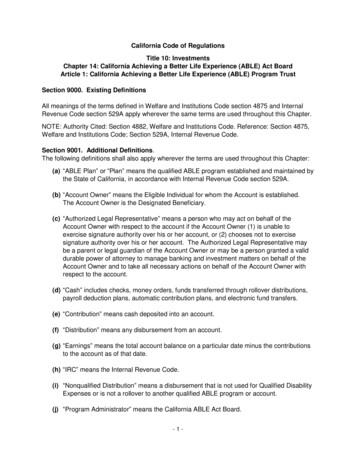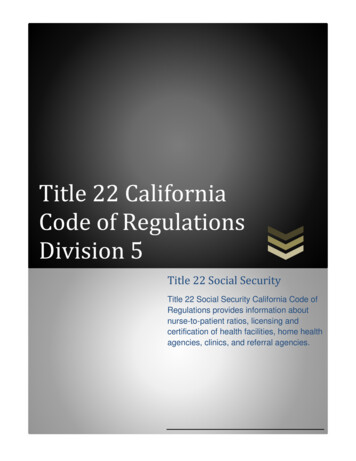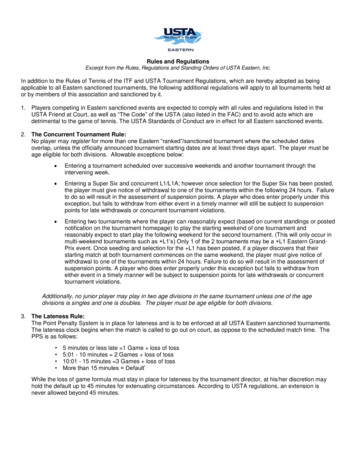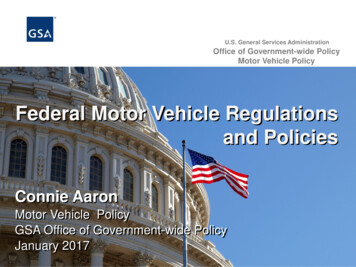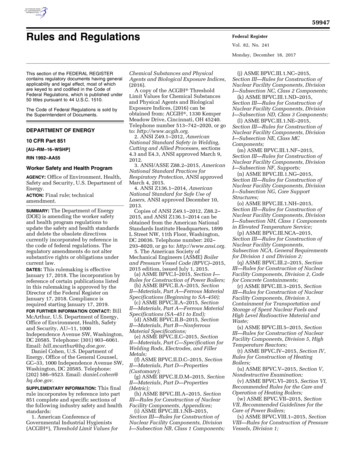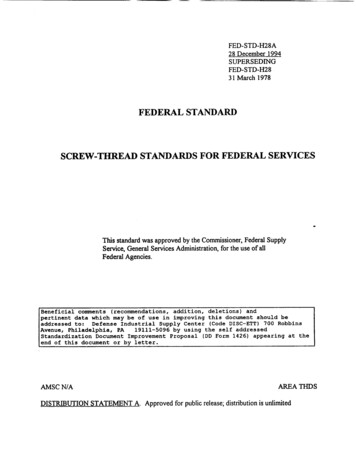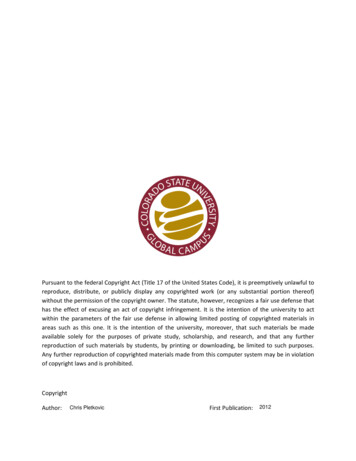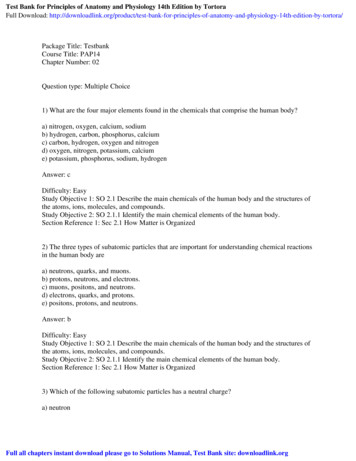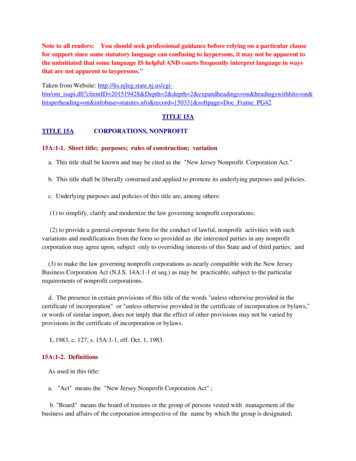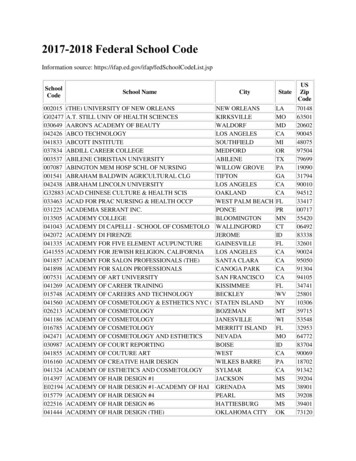![[Code Of Federal Regulations] [Title 21, Volume 8 .](/img/2/21-cfr-part-820.jpg)
Transcription
[Code of Federal Regulations] [Title 21, Volume 8][Revised as of September 27, 2016] [CITE: 21CFR820]TITLE 21--FOOD AND DRUGSCHAPTER I--FOOD AND DRUG ADMINISTRATIONDEPARTMENT OF HEALTH AND HUMAN SERVICESSUBCHAPTER H--MEDICAL DEVICESPART 820 QUALITY SYSTEM REGULATIONSubpart A--General Provisions§820.1 Scope.a) Applicability.1) Current good manufacturing practice (CGMP) requirements are set forth in this quality systemregulation. The requirements in this part govern the methods used in, and the facilities and controlsused for, the design, manufacture, packaging, labeling, storage, installation, and servicing of all finisheddevices intended for human use. The requirements in this part are intended to ensure that finisheddevices will be safe and effective and otherwise in compliance with the Federal Food, Drug, andCosmetic Act (the act). This part establishes basic requirements applicable to manufacturers of finishedmedical devices. If a manufacturer engages in only some operations subject to the requirements in thispart, and not in others, that manufacturer need only comply with those requirements applicable to theoperations in which it is engaged. With respect to class I devices, design controls apply only to thosedevices listed in §820.30(a)(2). This regulation does not apply to manufacturers of components or partsof finished devices, but such manufacturers are encouraged to use appropriate provisions of thisregulation as guidance. Manufacturers of blood and blood components used for transfusion or forfurther manufacturing are not subject to this part, but are subject to subchapter F of this chapter.Manufacturers of human cells, tissues, and cellular and tissue-based products (HCT/Ps), as defined in§1271.3(d) of this chapter, that are medical devices (subject to premarket review or notification, orexempt from notification, under an application submitted under the device provisions of the act orunder a biological product license application under section 351 of the Public Health Service Act) aresubject to this part and are also subject to the donor-eligibility procedures set forth in part 1271 subpartC of this chapter and applicable current good tissue practice procedures in part 1271 subpart D of thischapter. In the event of a conflict between applicable regulations in part 1271 and in other parts of thischapter, the regulation specifically applicable to the device in question shall supersede the more general.2) The provisions of this part shall be applicable to any finished device as defined in this part, intended forhuman use, that is manufactured, imported, or offered for import in any State or Territory of the UnitedStates, the District of Columbia, or the Commonwealth of Puerto Rico.3) In this regulation the term “where appropriate” is used several times. When a requirement is qualifiedby “where appropriate,” it is deemed to be “appropriate” unless the manufacturer can documentjustification otherwise. A requirement is “appropriate” if nonimplementation could reasonably beexpected to result in the product not meeting its specified requirements or the manufacturer not beingable to carry out any necessary corrective action.b) The quality system regulation in this part supplements regulations in other parts of this chapter except whereexplicitly stated otherwise. In the event of a conflict between applicable regulations in this part and in otherparts of this chapter, the regulations specifically applicable to the device in question shall supersede any othergenerally applicable requirements.c) Authority. Part 820 is established and issued under authority of sections 501, 502, 510, 513, 514, 515, 518, 519,520, 522, 701, 704, 801, 803 of the act (21 U.S.C. 351, 352, 360, 360c, 360d, 360e, 360h, 360i, 360j, 360l, 371,374, 381, 383). The failure to comply with any applicable provision in this part renders a device adulterated
under section 501(h) of the act. Such a device, as well as any person responsible for the failure to comply, issubject to regulatory action.d) Foreign manufacturers. If a manufacturer who offers devices for import into the United States refuses to permitor allow the completion of a Food and Drug Administration (FDA) inspection of the foreign facility for thepurpose of determining compliance with this part, it shall appear for purposes of section 801(a) of the act, thatthe methods used in, and the facilities and controls used for, the design, manufacture, packaging, labeling,storage, installation, or servicing of any devices produced at such facility that are offered for import into theUnited States do not conform to the requirements of section 520(f) of the act and this part and that the devicesmanufactured at that facility are adulterated under section 501(h) of the act.e) Exemptions or variances.1) Any person who wishes to petition for an exemption or variance from any device quality systemrequirement is subject to the requirements of section 520(f)(2) of the act. Petitions for an exemption orvariance shall be submitted according to the procedures set forth in §10.30 of this chapter, the FDA'sadministrative procedures. Guidance is available from the Food and Drug Administration, Center forDevices and Radiological Health, Division of Small Manufacturers, International and ConsumerAssistance, 10903 New Hampshire Ave., Bldg. 66, rm. 4613, Silver Spring, MD 20993-0002, 1-800-6382041 or 301-796-7100, FAX: 301-847-8149.2) FDA may initiate and grant a variance from any device quality system requirement when the agencydetermines that such variance is in the best interest of the public health. Such variance will remain ineffect only so long as there remains a public health need for the device and the device would not likelybe made sufficiently available without the variance.[61 FR 52654, Oct. 7, 1996, as amended at 65 FR 17136, Mar. 31, 2000; 65 FR 66636, Nov. 7, 2000; 69 FR 29829, May 25,2005; 72 FR 17399, Apr. 9, 2007; 75 FR 20915, Apr. 22, 2010; 80 FR 29906, May 22, 2015]§820.3 Definitions.a) Act means the Federal Food, Drug, and Cosmetic Act, as amended (secs. 201-903, 52 Stat. 1040 et seq., asamended (21 U.S.C. 321-394)). All definitions in section 201 of the act shall apply to the regulations in this part.b) Complaint means any written, electronic, or oral communication that alleges deficiencies related to the identity,quality, durability, reliability, safety, effectiveness, or performance of a device after it is released for distribution.c) Component means any raw material, substance, piece, part, software, firmware, labeling, or assembly which isintended to be included as part of the finished, packaged, and labeled device.d) Control number means any distinctive symbols, such as a distinctive combination of letters or numbers, or both,from which the history of the manufacturing, packaging, labeling, and distribution of a unit, lot, or batch offinished devices can be determined.e) Design history file (DHF) means a compilation of records which describes the design history of a finished device.f)Design input means the physical and performance requirements of a device that are used as a basis for devicedesign.g) Design output means the results of a design effort at each design phase and at the end of the total design effort.The finished design output is the basis for the device master record. The total finished design output consists ofthe device, its packaging and labeling, and the device master record.h) Design review means a documented, comprehensive, systematic examination of a design to evaluate theadequacy of the design requirements, to evaluate the capability of the design to meet these requirements, andto identify problems.i)Device history record (DHR) means a compilation of records containing the production history of a finisheddevice.j)Device master record (DMR) means a compilation of records containing the procedures and specifications for afinished device.
k) Establish means define, document (in writing or electronically), and implement.l)Finished device means any device or accessory to any device that is suitable for use or capable of functioning,whether or not it is packaged, labeled, or sterilized.m) Lot or batch means one or more components or finished devices that consist of a single type, model, class, size,composition, or software version that are manufactured under essentially the same conditions and that areintended to have uniform characteristics and quality within specified limits.n) Management with executive responsibility means those senior employees of a manufacturer who have theauthority to establish or make changes to the manufacturer's quality policy and quality system.o) Manufacturer means any person who designs, manufactures, fabricates, assembles, or processes a finisheddevice. Manufacturer includes but is not limited to those who perform the functions of contract sterilization,installation, relabeling, remanufacturing, repacking, or specification development, and initial distributors offoreign entities performing these functions.p) Manufacturing material means any material or substance used in or used to facilitate the manufacturing process,a concomitant constituent, or a byproduct constituent produced during the manufacturing process, which ispresent in or on the finished device as a residue or impurity not by design or intent of the manufacturer.q) Nonconformity means the nonfulfillment of a specified requirement.r) Product means components, manufacturing materials, in- process devices, finished devices, and returneddevices.s) Quality means the totality of features and characteristics that bear on the ability of a device to satisfy fitnessfor-use, including safety and performance.t) Quality audit means a systematic, independent examination of a manufacturer's quality system that isperformed at defined intervals and at sufficient frequency to determine whether both quality system activitiesand the results of such activities comply with quality system procedures, that these procedures areimplemented effectively, and that these procedures are suitable to achieve quality system objectives.u) Quality policy means the overall intentions and direction of an organization with respect to quality, asestablished by management with executive responsibility.v) Quality system means the organizational structure, responsibilities, procedures, processes, and resources forimplementing quality management.w) Remanufacturer means any person who processes, conditions, renovates, repackages, restores, or does anyother act to a finished device that significantly changes the finished device's performance or safety specifications,or intended use.x) Rework means action taken on a nonconforming product so that it will fulfill the specified DMR requirementsbefore it is released for distribution.y) Specification means any requirement with which a product, process, service, or other activity must conform.z) Validation means confirmation by examination and provision of objective evidence that the particularrequirements for a specific intended use can be consistently fulfilled.1) Process validation means establishing by objective evidence that a process consistently produces aresult or product meeting its predetermined specifications.2) Design validation means establishing by objective evidence that device specifications conform with userneeds and intended use(s).aa) Verification means confirmation by examination and provision of objective evidence that specified requirementshave been fulfilled.bb) Human cell, tissue, or cellular or tissue-based product (HCT/P) regulated as a device means an HCT/P as definedin §1271.3(d) of this chapter that does not meet the criteria in §1271.10(a) and that is also regulated as a device.
cc) Unique device identifier (UDI) means an identifier that adequately identifies a device through its distribution anduse by meeting the requirements of §830.20 of this chapter. A unique device identifier is composed of:1) A device identifier—a mandatory, fixed portion of a UDI that identifies the specific version or model of adevice and the labeler of that device; and2) A production identifier—a conditional, variable portion of a UDI that identifies one or more of thefollowing when included on the label of the device:i. The lot or batch within which a device was manufactured;ii. The serial number of a specific device;iii. The expiration date of a specific device;iv. The date a specific device was manufactured.v. For an HCT/P regulated as a device, the distinct identification code required by §1271.290(c) ofthis chapter.dd) Universal product code (UPC) means the product identifier used to identify an item sold at retail in the UnitedStates.[61 FR 52654, Oct. 7, 1996, as amended at 78 FR 58822, Sept. 24, 2013]§820.5 Quality system.Each manufacturer shall establish and maintain a quality system that is appropriate for the specific medical device(s)designed or manufactured, and that meets the requirements of this part.Subpart B—Quality System Requirements§820.20 Management responsibility.a) Quality policy. Management with executive responsibility shall establish its policy and objectives for, andcommitment to, quality. Management with executive responsibility shall ensure that the quality policy isunderstood, implemented, and maintained at all levels of the organization.b) Organization. Each manufacturer shall establish and maintain an adequate organizational structure to ensurethat devices are designed and produced in accordance with the requirements of this part.1) Responsibility and authority. Each manufacturer shall establish the appropriate responsibility, authority,and interrelation of all personnel who manage, perform, and assess work affecting quality, and providethe independence and authority necessary to perform these tasks.2) Resources. Each manufacturer shall provide adequate resources, including the assignment of trainedpersonnel, for management, performance of work, and a
TITLE 21--FOOD AND DRUGS CHAPTER I--FOOD AND DRUG ADMINISTRATION DEPARTMENT OF HEALTH AND HUMAN SERVICES SUBCHAPTER H--MEDICAL DEVICES PART 820 QUALITY SYSTEM REGULATION Subpart A--General Provisions §820.1 Scope. a) Applicability. 1) Current good manufacturing practice (CGMP) requirements are set forth in this quality system regulation. The requirements in this part
